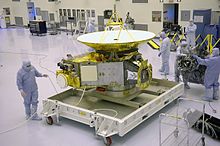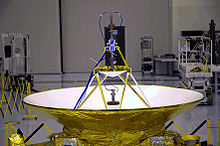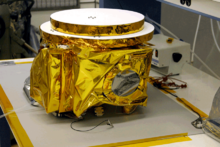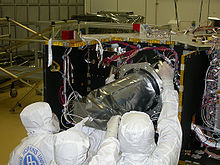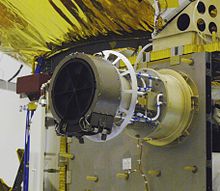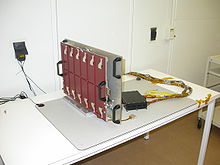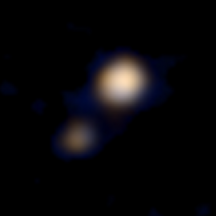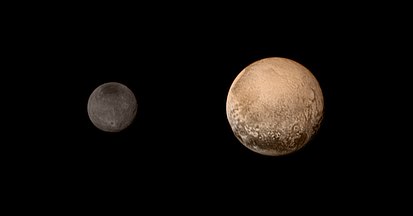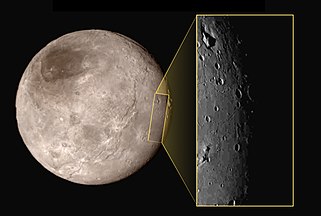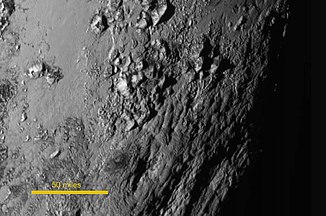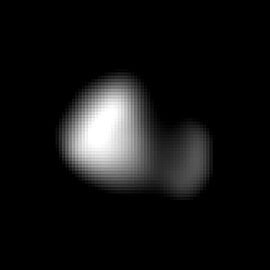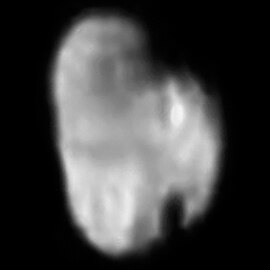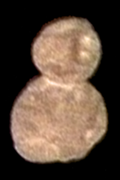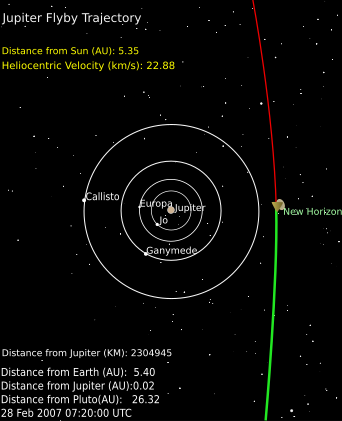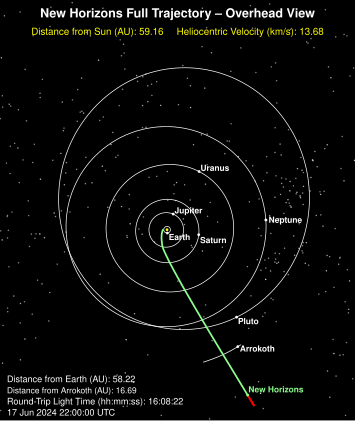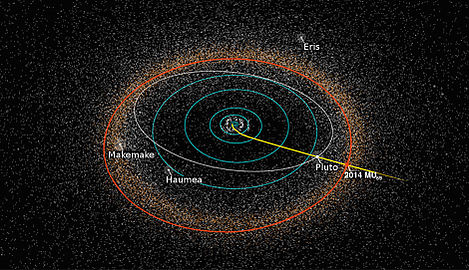New Horizons
| New Horizons | |||||||||||||||||||||||||||||||
|---|---|---|---|---|---|---|---|---|---|---|---|---|---|---|---|---|---|---|---|---|---|---|---|---|---|---|---|---|---|---|---|
 New Horizons in the assembly hall |
|||||||||||||||||||||||||||||||
| NSSDC ID | 2006-001A | ||||||||||||||||||||||||||||||
| Mission goal | Pluto system , Kuiper belt , heliosphere | ||||||||||||||||||||||||||||||
| operator |
|
||||||||||||||||||||||||||||||
| Launcher | Atlas V (551) | ||||||||||||||||||||||||||||||
| construction | |||||||||||||||||||||||||||||||
| Takeoff mass | 478 kg | ||||||||||||||||||||||||||||||
| Instruments | |||||||||||||||||||||||||||||||
|
|||||||||||||||||||||||||||||||
| Course of the mission | |||||||||||||||||||||||||||||||
| Start date | January 19, 2006, 19:00 UTC | ||||||||||||||||||||||||||||||
| launch pad | Cape Canaveral , LC-41 | ||||||||||||||||||||||||||||||
| End date | Primary mission at the end of 2016, secondary mission in 2021 | ||||||||||||||||||||||||||||||
|
|||||||||||||||||||||||||||||||
| Mission logo | |||||||||||||||||||||||||||||||
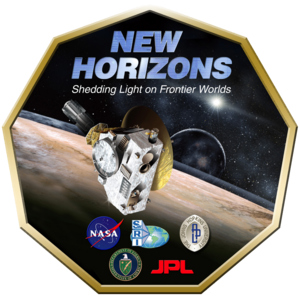
|
|||||||||||||||||||||||||||||||
New Horizons ( English for New Horizons ) is a space probe of NASA , which started as part of the New Frontiers program on January 19, 2006 to explore the Pluto system and the Kuiper Belt . On July 14, 2015, New Horizons became the first spacecraft to reach Pluto. In addition, she passed the Kuiper Belt Object ( 486958) Arrokoth on January 1, 2019 (at that time still unofficial: Ultima Thule ). The probe also explores other Kuiper belt objects from a greater distance as well as the heliosphere . Seven different instruments are used in the research: a 6 cm telescope , an ultraviolet spectrometer , a high-resolution CCD camera , a radio wave experiment , a solar wind particle detector, an ion and electron spectrometer and an instrument for measuring dust particles .
Currently (January 19, 2021) the probe is approx. 49.299 astronomical units (AU) from the sun, that is about 7.38 billion kilometers.
The project is led by the Applied Physics Laboratory at Johns Hopkins University in Baltimore , Maryland . The cost, including the development and construction of the spacecraft and its instruments, the launcher, and the mission operations through 2016, was approximately $ 700 million.
Mission objectives
Primary mission
New Horizons was the first spacecraft to explore Pluto. Since the dwarf planet is very far from the sun, even the most powerful telescopes could hardly see any details on its surface. The resolution of the best images obtained with the Hubble space telescope was only 500 km per pixel. Thus Pluto and its moons could only be studied more closely by space probes. At the time of the launch, Pluto was still considered a full-fledged planet and was the only planet that had not yet been explored by a space probe. A few months after the launch, the definition of planets was changed and Pluto became a dwarf planet under this new definition.
NASA divided the objectives of the probe's main mission into three priority categories; Moons discovered later could not be taken into account when formulating the mission objectives.
Required:
- Description of the global geological structure and geomorphology of Pluto and Charon
- Mapping the composition of the surfaces of Pluto and Charon
- Description of the neutral (non- ionized ) atmosphere of Pluto and determination of the loss of gas into space
Important:
- Description of the time-dependent variability of the surface and the atmosphere of Pluto
- Stereo recordings of Pluto and Charon
- Mapping of the day-night boundaries (terminator) of Pluto and Charon in high resolution
- Mapping of selected surface areas of Pluto and Charon in high resolution
- Description of Pluto's ionosphere and its interaction with the solar wind
- Look for specific chemical compounds such as hydrogen , hydrogen cyanide , hydrocarbons, and nitriles in Pluto's upper atmosphere
- Find an atmosphere with Charon
- Determination of the bolometric brightnesses and from this the geometric albedos of Pluto and Charon
- Mapping the surface temperatures of Pluto and Charon
Desirable:
- Description of the energetic particles near Pluto and Charon
- Refinement of the parameters ( radii , masses , densities ) and the orbits of Pluto and Charon
- Look for magnetic fields in Pluto and Charon
- Search for planetary rings and other moons
The mission objectives also included further exploration of Jupiter, which the probe passed in February and March 2007. Cloud movements were observed, it was the magnetosphere studied the planet and look for polar lights and flashes held in Jupiter's atmosphere. Little scientific data could be obtained about the four large Galilean moons because the probe passed them at a relatively great distance.
New Horizons exceeded all priority category targets. According to NASA's requirements, the mission would have been considered successful if only the mission objectives classified as necessary had been achieved.
In addition to the mission objectives formulated, the instruments contribute to research into the solar wind and the heliosphere with long-term observations.
Kuiper Belt Extended Mission (KEM)
In early July 2016, NASA approved the funding of a follow-up mission until 2021 to investigate (486958) Arrokoth and other objects in the Kuiper Belt . The follow-up mission under the name Kuiper Belt Extended Mission (KEM) has several goals:
- A close flyby of the "old" Kuiper belt object (486958) 2014 MU 69 , today (486958) Arrokoth, on January 1st, 2019. The flyby should take place at a distance of only 3500 km. After that, observation should be continued for a week
- The recordings in visible light and in other spectral ranges should be more detailed than with Pluto according to the greater proximity.
- The observation of this asteroid of medium size from 20 to 40 km should provide new knowledge about the accretion processes and thus the formation of the planets and the solar system. The object is believed to be more than four billion years old and has been in a cold environment since its creation. It is expected to be the most original object that has been examined by a space mission by then.
- New Horizons should use all seven tools in the exploration.
- Search for possible moons.
- Investigation of the surface structures.
- Find an atmosphere.
New Horizons is also to be used as an observation platform to observe other objects in the Kuiper Belt and the surrounding space area:
- 2016–2020: Observation of around 20 further Kuiper Belt Objects (KBOs) from a greater distance in order to determine their shape, accompanying objects and surface properties; no earth-based telescope can do this.
- 2016–2020: Careful search for a large number of different KBOs.
- 2016–2021: Creation of a heliosphere cross-section through the Kuiper Belt with almost permanent measurement of plasma , dust particles and neutral gases up to a distance of 50 AU from the sun.
- 2020–2021: Possible astrophysical investigation, as requested by NASA.
technology
The spacecraft is roughly the size of a concert grand piano and shaped like a triangle with a cylindrical radioisotope generator (RTG) attached to one point of the triangle. It also has a 2.1 m parabolic antenna for communication with the earth, which is attached to one side of the triangle. The probe body without RTG and antenna is 0.7 m high, 2.1 m long and 2.7 m wide. The total height from the payload adapter to the top of the antenna is 2.2 m. The total mass including 77 kg of fuel and 30 kg of scientific payload is 478 kg. The original plans envisaged a launch mass of the fully fueled probe of 465 kg; After the performance of the new Atlas V launcher had been verified by previous launches, the launch mass was increased somewhat.
The swing-by maneuver on Jupiter was available until shortly before the start ; a flight without this swing-by would only have allowed the launch mass of the probe to be around 20 kg less, since the launch vehicle would have to reach a higher final speed in the case of a direct launch to Pluto. In this case, the amount of hydrazine carried would have had to be reduced, which would also have limited the possibilities for secondary emissions.
The carrying structure of the probe consists of a central aluminum - cylinder , of the made titanium home-made fuel tank and serves as the payload adapter between the probe and the carrier rocket as well as the interface between the probe and the RTG. The RTG is attached to the space probe using a four-sided titanium base. In order to keep the mass of the probe low, the panels of the probe body are made of aluminum in a sandwich construction with very thin frontal plates (as thick as two layers of paper). Electronics and instruments are grouped around the cylinder, whereby the arrangement of the systems had to take the center of gravity into account.
New Horizons can be operated with three axes as well as with spin stabilization . Three-axis stabilization is used during scientific observations and system and instrument tests, spin stabilization (usually at five revolutions per minute) during course correction maneuvers, during long radio contacts with the earth, during periods of flight and at rest (hibernation mode). In order to enable spin stabilization during the flight, the probe was precisely measured before take-off and balanced with additional counterweights.
power supply
The energy supply cannot be achieved with solar cells for missions far from the sun . The probe is supplied with energy by a radioisotope generator (RTG) of the type GPHS-RTG filled with approximately 10.9 kg of plutonium -238 . The voltage is 30 volts . The RTG of the probe contains 18 modules, each containing four capsules with 151 g of plutonium each in the form of plutonium (IV) oxide .
The plutonium-238 for RTGs is bred in a complex process by neutron bombardment of fuel rods containing neptunium- 237 in a nuclear reactor . The capsules were made in the Los Alamos National Laboratory of the US Department of Energy (DOE). In mid-2004, all work at the Los Alamos National Laboratory, and thus also on the plutonium for New Horizons, was stopped because some hard drives with secret information supposedly disappeared. The project was in danger because the probe would not have been able to carry out any observations, or only to a limited extent, if the energy supply was inadequate. However, the Los Alamos National Laboratory's safety issues were resolved and work on the plutonium capsules resumed. At the end of 2005 the RTG was delivered and installed in the probe.
It was planned that the maximum power of the generator with a full plutonium charge would be 285 W at take-off and 225 W for the pluto flyby in 2015 (due to the decay of the plutonium, the available power is reduced over time). After problems with the manufacturing, DOE spoke of about 190 W of available power when flying past Pluto. This would be sufficient for normal operation of the probe at Pluto (at least 182 W are required) and could keep the probe functional until around 2025 . When the RTG was subjected to tests in October 2005, it turned out that the generator could deliver a little more power than expected. It was assumed that about 240 W at the beginning of the mission and 200 W when it reached Pluto.
electronics
New Horizons has two computer systems: the Command and Data Handling System for controlling the probe and working with scientific data, and the Guidance and Control System for position control. Each of the computer systems is designed redundantly so that the space probe has four separate computer systems. The on-board computers each use a Mongoose V processor. This is a 12 MHz fast, radiation- hardened version of the MIPS-R3000 processor.
The Command and Data Handling System has two flash recorders, each with 8 GB storage capacity, to temporarily store the scientific data obtained during operation of the instruments before they can be transmitted to Earth.
In order to save space and weight, the electronics of the space probe and the interfaces to the electronics of its instruments are housed in an "Integrated Electronics Module" (IEM). There are two redundant IEMs on board. The installation of new software is planned for 2020; [obsolete] this is intended to give New Horizons improved research capabilities for the next decade.
communication
The space probe's communication system works in the X-band and has a 2.1 m parabolic high gain antenna (High Gain Antenna - HGA, 42 dBi) with an opening angle of 0.3 ° and a 30 cm medium gain antenna (Medium Gain Antenna - MGA) with an opening angle of 4 °. In addition, there are two omnidirectional low gain antennas (LGA) on opposite sides of the spacecraft. All antennas are firmly attached. To use the HGA and MGA antennas, the probe must be directed towards the earth. The probe has two redundant 12-watt traveling wave tube amplifiers (TWTA) mounted under the HGA. The signals of the TWTAs are polarized differently, so both TWTAs can be used for transmission at the same time.
The high gain antenna and the medium gain antenna are used for data transmission; the data transmission rate from the HGA to a 70 m antenna of the Deep Space Network was 38 kbit on Jupiter, and around 1 kbit per second near Pluto . The much older Voyager probes achieved around 1.4 kbit per second in the X-band due to their larger antenna dishes at a similar distance.
In the event that the probe cannot be aligned with the earth and these antennas are not available, the two omnidirectional antennas (LGA) of the probe can be used. These do not need to be aligned, but only achieve very low data transfer rates. Since these antennas are located on opposite sides, the probe can transmit and receive in all directions regardless of its location. The LGA were used during take-off and for communication near the earth and also serve to secure communication in an emergency with the lowest possible data rate of 10 bits per second.
In order to lower the operating costs, New Horizons spent the flight route between Jupiter and Pluto and partly between Pluto and (486958) Arrokoth in a kind of "hibernation mode". The probe was "woken up" once a year for 50 days in order to carry out functional tests and determine exact flight parameters. For the rest of the time, the probe was set in slow rotation. In this state, it only sends a signal to earth once a week, the frequency of which indicates either normal operation of the probe or one of seven failure modes. A simple, unmodulated carrier wave of a certain frequency is used for this, which is easy to receive and can be identified without much technical effort. The probe sends a more detailed status report about once a month. Only one of the four on-board computers is in operation and all redundant systems are switched off as far as possible. Hibernation reduces wear and tear and considerably reduces maintenance costs because no personnel are required for operation and the capacity of the Deep Space Network is freed up for other missions. This type of communication was tested with the Deep Space 1 test probe ; New Horizons is the first spacecraft to use it in operational missions.
Drive system
The space probe's drive system is only used for course corrections and position control. It is not possible to strongly accelerate or decelerate the probe again after it has been separated from the rocket upper stage, as would be necessary, for example, in an orbiter mission. The propulsion system consists of 16 propulsion units which are attached to eight different points on the surface of the probe and which catalytically decompose hydrazine . Four of them are mainly used for course corrections; they deliver a thrust of 4.4 Newtons each . The other twelve are smaller and each generate 0.8 Newtons of thrust; they are used to align the probe and to initiate and stop the rotation. Half of the 16 engines serve as a reserve.
At the start, the probe had 77 kg of hydrazine on board, which would be sufficient to change the speed of the probe by around 400 m / s (a minimum of 290 m / s was envisaged in the mission planning). The largest part is intended to be able to control further Kuiper belt objects after the passage of Pluto. The fuel is pressurized with gaseous helium and injected into the engines.
Navigation systems and sensors provide information on the position, course and spatial orientation of the probe during flight. These data are used to correct course and to align the instruments with the targets and the antenna with the earth.
To navigation are two redundant A-STR star trackers (Star Tracker), inertial measurement systems ( Inertial Measurement Units , IMU) and sun sensors used. The navigation data is processed by the guidance and control computer system, which controls the position of the probe by igniting the small engines. One of the star cameras takes wide-angle photos of the star background ten times per second and compares them with a stored star map that contains around 3000 stars. This determines the exact alignment of the probe in both three-axis-stabilized and spin-stabilized operation. The IMUs, which consist of gyroscopes and accelerometers , provide information about the movement of the probe 100 times per second. The sun sensors are used to align the probe with the sun (and thus also with the earth from a great distance) and to ensure communication in the event that other navigation systems fail. These sensors have a very simple structure and only signal whether they can see the sun or not.
Temperature control
New Horizons can keep the heat generated by electronics inside like a vacuum jug . Given the great distance from the sun, this is necessary to ensure temperatures of 10 to 30 ° C inside. For this purpose, the probe body, including the large antenna, is provided with a lightweight, gold-colored cover consisting of 18 layers of dacron fabric , which are sandwiched between an aluminized mylar fabric and a Kapton film . In addition to thermal insulation, this cover also serves to protect against micrometeorites .
An automatic heating system monitors the energy consumption inside the probe to ensure that all devices are working with sufficient power and thus emit enough heat. If the energy requirement falls below around 150 watts, small heating devices inside the probe are switched on to compensate for the difference in performance. As long as the probe was near the earth and thus also the sun, the temperatures could exceed the permissible values. In this case, the probe has a kind of louvre system with slats that have been opened to radiate excessive heat into space. When closed, the bright outer surface of the slats ensures low radiation.
Instruments
The probe carries seven scientific instruments. Some instruments are grouped together; Sun includes Pluto Exploration Remote Sensing Investigation (PERSI) the instruments Ralph and Alice and Particle Spectrometer suite (PAM) , the instruments SWAP and PEPSSI. The instruments together have a mass of around 30 kg and together consume around 28 watts of electrical power.
Ralph
Ralph was able to create colored maps of the surfaces of Pluto and Charon with a resolution of up to 250 m per pixel, as well as map the composition of the surfaces of both bodies. For this purpose, the instrument has a 6 cm telescope whose collected light is directed to two separate channels: to the Multispectral Visible Imaging Camera ( MVIC ), which has four CCDs for color images with three CCDs for panchromatic (black and white) images , and the Linear Etalon Imaging Spectral Array (LEISA). MVIC works in the visible light range at 400 to 950 nm wavelength and LEISA in the infrared range at 1.25 to 2.50 µm wavelength. The resolution of the MVIC is 20 µrad, the LEISA 62 µrad. Ralph weighs 10.3 kg and requires an average of 6.3 watts of power. The instrument was developed by Ball Aerospace , NASA's Goddard Space Flight Center, and the Southwest Research Institute . On June 22, LEISA was officially renamed the Lisa Hardaway Infrared Mapping Spectrometer in honor of Lisa Hardaway , who made important contributions to the design and development of the instrument.
Alice
Alice is an imaging ultraviolet spectrometer for studying the atmosphere of Pluto. Alice can be operated in two modes: in "Airglow mode", in which the emissions of the atmosphere are measured, and in "Occultation mode", in which the instrument is directed through Pluto's atmosphere at the sun or another bright star and the composition of the atmosphere is determined by the absorption of light. Alice works in the ultraviolet light range with a wavelength of 50 to 180 nm and consists of a compact telescope, a spectrograph and a sensor, which has 32 separate surfaces ("pixels") with 1024 spectral channels each. Alice weighs 4.5 kg and requires an average of 4.4 watts of power. The instrument was developed by the Southwest Research Institute and is a further developed version of the Alice instrument of the European Rosetta probe, which also came from the USA.
LORRI (Long Range Reconnaissance Imager)
LORRI is a high-resolution CCD camera (1024 × 1024 pixels) for visible light, which is mounted on a Ritchey-Chrétien reflector telescope . The mirror has a diameter ( aperture ) of 20.8 cm, the primary and secondary mirrors are made of silicon carbide . The camera has an angle of view of 0.29 ° and a focal length of 2630 mm with a resolution of 4.95 µrad. The instrument is very simple, it has no color filters or moving parts. Its sensitivity range covers the light spectrum from 350 to 850 nm wavelength. The image sensor is operated at a temperature of −70 ° C. LORRI weighs 8.8 kg and requires an average of 5.8 watts of power. The instrument was developed by the Applied Physics Laboratory at Johns Hopkins University . Already 120 days before the encounter with Pluto, LORRI was the first instrument to take pictures of the dwarf planet and its moons, which at that time could hardly be resolved further than individual points of light. 90 days before the encounter, LORRI's resolution exceeded that of the Hubble space telescope . During the close flyby of Pluto, LORRI was able to resolve structures up to 50 m in size. New software for this camera was uploaded to the probe in July 2019. The software allows longer exposure times and enables the observation of less light objects than before.
REX (Radio Experiment)
REX is a radio wave experiment performed with the main antenna of the probe. For this purpose, after passing Pluto, signals were sent to the probe with the help of antennas of the Deep Space Network, which were changed during the passage through Pluto's atmosphere and reached New Horizons in this state. The signals were saved and later transmitted back to earth. This allows the composition of the atmosphere to be studied. The experiment itself consists of a small, 100 g heavy circuit board with signal processing electronics, which is integrated in the space probe's communication system and required an average of 2.1 watts of power. Since the entire communication system is redundant, New Horizons has two copies of REX. The experiment was developed by Stanford University and the Applied Physics Laboratory at Johns Hopkins University.
SWAP (Solar Wind Analyzer around Pluto)
This instrument measured charged particles with energies up to 6.5 keV that escape from Pluto's atmosphere and are swept away by the solar wind . This was to determine if Pluto had a magnetosphere. Furthermore, the solar wind could be studied near Pluto. It also collected data on the atmosphere. SWAP weighs 3.3 kg and requires an average of 2.3 watts of power. The instrument was developed by the Southwest Research Institute. SWAP is also used to explore the heliosphere and the Kuiper Belt and can also collect data during hibernation.
PEPSSI (Pluto Energetic Particle Spectrometer Science Investigation)
PEPSSI is an ion and electron spectrometer that looked for neutral atoms escaping from Pluto's atmosphere and being charged by the solar wind. Ions with energies from 1 to 5000 keV and electrons with energies from 20 to 700 keV entering the instrument are recorded, with the mass and energy of each individual particle being measured. PEPSSI weighs 1.5 kg and requires an average of 2.5 watts of power. The instrument was developed by the Applied Physics Laboratory at Johns Hopkins University. PEPSSI is also used to explore the heliosphere and the Kuiper Belt, and can also collect data during hibernation.
Venetia (Venetia Burney Student Dust Counter)

Venetia is an instrument for measuring dust particles along the entire flight route. Developed by students at the University of Colorado , it is the first student-built instrument on a NASA planetary mission. The device was initially called the Student-built Dust Counter (SDC), but was renamed in June 2006 in honor of the British Venetia Phair , née Burney, who in 1930 proposed the name "Pluto" for the newly discovered planet. The Venetia instrument counts dust particles and determines their mass. It is the first instrument of its kind to operate more than 18 AU from Earth. It provides information that is used, among other things, to estimate the collision rate of asteroids, comets and Kuiper belt objects in the outer solar system. Venetia can also collect data during hibernation. The instrument consists of a 46 cm × 30 cm detector plate, which is attached to the outer skin of the probe, and an electronics box inside the probe. Particles with a mass of 4 · 10 −15 to 4 · 10 −12 kg can be detected. Venetia weighs 1.9 kg and requires an average of 5 watts of power.
Preparations and start
Preparations
Efforts have been made to start a mission to Pluto since the early 1990s. The priority was to get to Pluto before its thin atmosphere would freeze out, because the dwarf planet's orbit is very eccentric . Pluto reached the point of its orbit closest to the Sun ( perihelion ) as early as 1989. However, this assumption that the atmosphere would soon freeze out after passing through the orbit area closer to the Sun has not yet been confirmed. Pluto is currently moving away from the sun so that it is getting colder and colder on it; not until 2247 will he have his next perihelion. The first concepts of a mission (Pluto Fast Fly-By, Pluto Kuiper Express) failed due to technical and financial difficulties. At the end of 2000 there was a new proposal for a Pluto mission with New Horizons. Finally, this proposal was approved for implementation on November 29, 2001 as the first mission of NASA's newly created New Frontiers program .
The probe's instruments were delivered between July 2004 and March 2005, assembly and testing ran from August 2004 to May 2005. From May to September 2005 the completed probe was extensively tested, and on September 24, 2005 it was transported to Cape Canaveral .
At the end of October, Hurricane Wilma damaged a solid fuel booster for the almost completely assembled Atlas V launcher for New Horizons in Cape Canaveral when a gate in the assembly hall could not withstand the wind pressure. However, the booster could be replaced in good time before the planned start date on January 11, 2006.
On December 16, 2005, NASA ordered an additional inspection of the tanks of the first rocket stage , because in a pressure test of another Atlas rocket this stage had not withstood the required maximum load. As a result, the start date set for January 11th was postponed by six days to January 17, 2006.
begin
| Starting window 2006 | |
|---|---|
| begin | Arrivals |
| Jan. 11-27 | July 14, 2015 |
| Jan. 28 | Aug 15, 2015 |
| Jan. 29 to 31 | July 12, 2016 |
| Feb 1st and 2nd | 11th July 2017 |
| 3rd to 8th Feb. | July 10, 2018 |
| Feb 9-12 | June 7, 2019 |
| Feb 13 and 14 | 20th July 2020 |
| Start window 2007 | |
| Feb 2nd to 15th | 2019 to 2020 |
The launch window opened on January 11, 2006 and lasted until February 14, 2006. However, there was only the possibility of a flyby (swing-by maneuver) at Jupiter if the flight took off up to and including February 2nd. After that, Pluto could only have been reached directly, which would have extended the flight time by several years and reduced the amount of fuel that could be carried by 20 kg.
After the planned start on January 17, 2006 had to be postponed several times due to strong winds, New Horizons should start on January 18, 2006. Due to a power outage at the Johns Hopkins University ground station, this appointment could not be kept either. On January 19, New Horizons finally took off from Launch Complex 41 at 7:00 p.m. UTC (the launch window was open from 6:07 p.m. to 8:07 p.m. UTC ) after several postponements due to dense cloud cover . After 44 minutes and 55 seconds, the missile launched the probe into its final flight path.
Although the used Atlas V rocket was at that time the strongest active launch vehicle in the world, the payload had an additional Star-48B - Kick stage are equipped to the probe at a speed well above the escape velocity to accelerate. New Horizons left the earth at the highest speed ever achieved of 16.21 km / s. On other days of the start window the speed would have been a little different. Especially after February 2nd, without the possibility of flying past Jupiter, the speed of the probe should have been significantly higher.
Observation in the Jupiter system
On the way to Jupiter
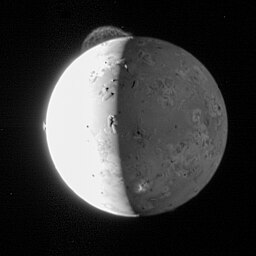
One day after the start, the rotation of the probe was reduced from 68 revolutions per minute, in which it had been set by the rocket upper stage, to 19.2 revolutions per minute. On January 22nd, the rotation was further reduced to 5 revolutions per minute and the star cameras were put into operation.
On January 28, 2006, a first course correction (TCM-1A) was carried out, with the engines firing for about five minutes. Two days later, the next twelve-minute course correction (TCM-1B) followed. The two course corrections resulted in a speed change of 18 m / s. Another course correction (TCM-2) was planned for February 15, but was canceled. The next 76 second course correction (TCM-3) took place on March 9, 2006 and was the first to be carried out in three-axis stabilized operation. TCM-3 changed the speed of the probe by 1.16 m / s.
The protective cap of the Alice spectrometer had already been opened in February 2006; the SWAP instrument followed on March 13th. The SDC experiment was also activated in March. By March 29th, all instruments had passed their internal electronics checks. On April 7, 2006, the probe crossed Mars orbit after a flight time of 78 days . In May, the protective caps of the PEPSSI (May 3), Alice (May 20) and Ralph (May 29) instruments were opened. The experiments were calibrated in the summer .
New Horizons approached the 3 to 5 km large asteroid (132524) APL on its way through the asteroid belt on June 13, 2006 at 04:05 UTC to within 101,867 km . The protective shutter of the high-resolution camera LORRI was only opened on August 29, 2006, so visual observations were only made with the weaker Ralph instrument. This could only resolve the asteroid as an object one or two pixels in size.
On September 4, 2006, New Horizons took its first image of Jupiter from a distance of 291 million kilometers . It was generated with the LORRI camera. Other instruments also observed Jupiter, primarily for the purpose of calibration.
Fly by Jupiter
Scientifically relevant investigations of the Jupiter system began in January 2007 and lasted until the end of June 2007. About 700 observations and measurements of the gas planet, its moons and its magnetosphere were planned. New Horizons was the eighth spacecraft to reach Jupiter.
On February 28, 2007, New Horizons passed Jupiter. The closest distance to the planet was reached at 05:43 a.m. UTC and was about 2.3 million kilometers (about 32 Jupiter radii). This is a third of the distance that the Saturn probe Cassini-Huygens passed Jupiter. New Horizons' trajectory was just outside the orbit of Callisto , the outermost of the four Galilean moons . The probe provided new knowledge about the planetary system. During the flyby, she took pictures of Jupiter, its rings and the four Galilean moons, and measurements of the magnetic field were carried out. A volcanic eruption was observed on Io . As a result of the flyby, the probe experienced an increase in speed of 3890 m / s and was redirected onto a trajectory to Pluto, for which it was deflected northward out of the ecliptic by about 2.5 ° . The flight time to Pluto could thus be reduced by several years compared to a flight path without flying past Jupiter.
Area of the outer planets
On June 8, 2008, New Horizons crossed Saturn's orbit , but stayed a long way from it. A course correction was carried out on June 30, 2010 and the speed of the probe was increased by about 0.45 m / s by a thrust pulse of 36 seconds in order to compensate for a deceleration caused by thermal radiation backscattered by the isotope generator at the HGA. The probe reached Uranus ' orbit on March 18, 2011 at 11 p.m., at which time the gas giant was more than 3.8 billion kilometers away and therefore no observations were made. On 25/26 August 2014, Neptune entered orbit , exactly 25 years after Voyager 2 passed Neptune. Neptune, too, was too far from New Horizons for meaningful observation; nevertheless, on July 10, 2014, some pictures of Neptune were made from a distance of almost four billion kilometers.
They also wanted to watch Neptune Trojans such as 2011 HM 102 , if they got close enough to the probe. However, since New Horizons approached within 180 million km at most, which was insufficient for a meaningful observation, an observation was finally dispensed with.
Pluto and Charon
Observations of the Pluto-Charon system began about 150 days before the closest approach. On April 15, 2015, the first combined color picture of Pluto and Charon was published. The images from the LORRI camera already exceeded the best resolution of the Hubble space telescope . In the following weeks, ever more detailed images of Pluto's surface and its largest companion were published at intervals of three to six days.
On July 4, 2015, ten days before the flyby, New Horizons went into safety mode due to a computer problem. The computer was in the process of compressing the last images and saving them to the flash memory when the extensive commands for the observation plan were received at the same time. This led to an overload and blockage of the computer system, after which it was automatically switched to the redundant B-side computer system. The DSN made all the necessary resources for communication with the probe available for troubleshooting. On July 7, 2015, the bug was fixed and New Horizons was able to resume scientific operations. During the flyby it was not possible for the probe to switch to safety mode.
On July 14, 2015, the probe passed the dwarf planet at a speed of 14.5 km / s and thus reached the goal of its primary mission. Pluto was 32.9 AU from the Sun at this point . Global maps of Pluto and Charon were created, high-resolution photos with up to 25 m per pixel resolution were obtained, the temperature distribution was measured and the surface and atmosphere of the planet were studied. As planned, the probe flew past Pluto at 13:50 CEST at a distance of 12,500 km and at 14:04 CEST at a distance of 28,800 km past Charon. At 14:51 CEST she crossed the shadow of Pluto and at 16:18 CEST that of Charon; in doing so, she gained data on their atmosphere. The particularly data-intensive phase of the flyby lasted - depending on the definition - a maximum of three hours.
Since the data transmission rate was too low for real-time transmission due to the great distance between the probe and the earth, the data was temporarily stored on the 8 GB flash memory of the on-board computer. In the week after the flyby, particularly important data was initially sent. This was followed by ongoing measurements from experiments such as SWAP and PEPSSI, which only produced a small amount of data and which continue to carry out measurements even after the flyby. From September 5, 2015 to October 25, 2016, all saved data from the flyby was transferred in full data quality. The entire transfer took more than 15 months.
July 14: Charon's surface, right enlargement with compression artifacts
More Pluto moons
The small Pluto moons Nix and Hydra were discovered a few months before the rocket launch in 2005, Kerberos and Styx in 2011 and 2012 on long-exposure images of the Pluto system through the Hubble space telescope. In the phase of closest convergence, the observations focused entirely on Pluto and Charon. However, there are some pictures of the small moons that were made with LORRI and Ralph from a greater distance.
Kuiper Belt Extended Mission (KEM)
By October 2014, possible targets for the New Horizons secondary mission in the Kuiper Belt had been identified with the Hubble Space Telescope . As part of the Citizen Science project Ice Hunters , volunteers evaluated images that had been obtained by subtracting images taken at intervals. Of the five targets found, two were out of range. From the remaining three, NASA selected the object (486958) 2014 MU 69 - today (486958) Arrokoth - as the next target of the spacecraft. NASA approved funding for the secondary mission in early July 2016. The mission is known as the Kuiper Belt Extended Mission (KEM) and is funded until 2021. It passed the asteroid at a distance of only 3,500 km; all instruments were used that had previously been used to observe Pluto. The subsequent transmission of the data is expected to take around 20 months by the end of 2020. At the time of the flyby, the object was unofficially named Ultima Thule ; this name was chosen after a public poll and a poll of the mission team. The final designation as (486958) Arrokoth took place in November 2019.
Preliminary study of (486958) Arrokoth
The scientists wanted to know as much as possible about the target object of the mission in advance. B. about the orbit data, the duration of rotation, accompanying objects, ring systems and debris. On the one hand, you wanted to be sure that there was no risk of collision with an accompanying object or dust particles when flying past. On the other hand, it was necessary to find the optimal passage distance, which would be both large enough to have time to obtain all the important data and small enough for a good resolution of the images. A closer flyby would have resulted in fewer, higher-resolution images, whereas a flyby at a greater distance would have produced more images, but in lower resolution.
(486958) Arrokoth, at that time still called MU 69 in 2014 , was 30 to 45 km in size according to initial observations by Hubble. Among other things, the Gaia mission provided data for predicting star occultations. There were occultations on June 3 and July 10 and 17, 2017. Astronomers used this to get information about the diameter and accompanying debris or a ring system in advance. For the observation of the occultation, teams with 22 mobile 40 cm telescopes and cameras were brought to South Africa and Argentina, which are set up at a distance of approx. 10 to 25 km along the occultation line to ensure that at least one of the telescopes is occult can observe in the center. The occultations lasted approximately 2 seconds.
The data from the cover on June 3rd brought surprising results. The coverage could not be determined from any of the observation points, although all were correctly positioned. The scientists concluded that the object is smaller than what Hubble's observations suggested, and that the size is therefore rather below the originally assumed 30 to 40 km. Accordingly, the object either had to be highly reflective or it was a binary system or even a swarm of small objects that were left over when the solar system was formed. The 2.5 m flying telescope of the Stratospheric Observatory for Infrared Astronomy (SOFIA) was also used to observe the occultation on July 10th . The occultation on July 17, 2017 could be determined and suggested that the object is elongated but shorter than 30 km. Alternatively, a binary system has been proposed in which the two components are each 15-20 km in size.
Another occultation took place on August 4, 2018. Mobile telescopes were posted in Senegal and Colombia for observation. This cover could be observed and, like the cover on July 17, 2017, showed no evidence of debris or a ring system; in addition, the orbit data could be further refined. From this point on, only LORRI was left to further identify possible debris.
Preparing for the flyby

More than three years before the encounter with the asteroid, New Horizons' engines were fired for 25 minutes each on October 22, 25, 28 and November 4, 2015 in order to bring the probe on course for 2014 MU 69 . The spacecraft used 35% of its fuel reserves to turn on the new course; the other two possible targets 2014 OS 393 and 2014 PN 70 would have required significantly more fuel to change course.
On February 1, 2017, the engines were ignited for 44 seconds for a small course correction. It came from the latest results from Hubble's 2016 orbit observation and from New Horizons position data. In the previous weeks, the spacecraft had observed six Kuiper belt objects. Due to an error loading commands into the on-board computer, New Horizons temporarily went into safety mode on February 9, 2017.
After 852 days of uninterrupted operation, New Horizons was in hibernation mode for 157 days from April 7, 2017 to September 11, 2017. Between September 11th and December 21st, 2017 the probe was activated and observed various objects with LORRI and with the UV spectrometer Alice. On December 9th, the engines were ignited for 2.5 minutes in order to adjust the course and to optimize the timing of the encounter so that the antennas of the Deep Space Network could optimally evaluate the event.
Fly by Arrokoth ("Ultima Thule")
From December 21, 2017 to June 4, 2018, the probe was again in hibernation mode. After reactivation and extensive functional tests, it was switched from rotation mode to " 3-axis mode " on August 13, 2018 . On August 16, 2018, LORRI took the first long-term exposures of Arrokoth (then called "Ultima Thule"). The object was recorded as a tiny point in front of a dense star field exactly at the predicted location and the orbit data had already been precisely determined. On October 3, 2018, the engines were ignited for three and a half minutes to correct the speed by 2.1 m / s. At a distance of 6.35 billion km from Earth, this was the most distant course correction to date. For the first time, the images of the asteroid made by the probe were used to determine the course.
Up to December 15, no rings, moons or accompanying objects were found and it was finally decided to fly by close at a distance of 3500 km. On December 19, the small engines were ignited for 27 seconds, the speed was changed by 0.26 m / s, the course by 300 km and the flight time by 5 seconds. On December 20, the final observation program was transferred to the probe. On December 26, 2018, the probe switched to "Encounter Mode". It now worked autonomously, and the on-board software would have automatically switched to reserve systems in the event of problems. As with the Pluto flyby, New Horizons could neither react to commands nor switch to safety mode during this phase, but instead carried out the observation program with first priority. The encounter with “Ultima Thule” took place on January 1, 2019 at a distance of 43.3 AU from the sun. Among other things, radar measurements were carried out to determine the surface properties of the asteroid. Radio signals from the probe took more than 12 hours at this distance to reach Earth. The Deep Space Network received the first data of the flyby on January 1, 2019 at 3:32 p.m. ( UTC ). The next day the first high-resolution image was published. After all data has been transferred, the probe is to be put back into standby mode at the end of 2020.
(15810) Arawn
On November 2, 2015, LORRI made several recordings of (15810) Arawn, each one hour apart. At the time of the acquisition, the object was approximately 5.3 billion km from the Sun, but only 280 million km from New Horizons. Another observation was made from April 7th to 8th, 2016 from a distance of 111 million km. Simultaneous observation with Hubble made it possible to determine the path of the object using parallax with an accuracy of less than 1000 km. The assumption that it was a quasi-satellite of Pluto was thus refuted. The observation also gave a rotation period of 5.47 hours and an estimate of the diameter of 145 km. It was also found that the surface of the asteroid is relatively uneven.
(50000) Quaoar
On July 13 and 14, 2016, LORRI took four pictures of Quaoar . The recordings from a distance of 2.1 billion km only show the object as a blurred point. The photo is still of scientific value because the object was recorded from a different angle than from the earth. New knowledge was gained about the light scattering on its surface.
(516977) 2012 HZ 84 and 2012 HE 85
In December 2017 LORRI took pictures of the two Kuiper belt objects (516977) HZ 84 and 2012 HE 85 to look for moons, rings and accompanying accumulations of dust. These images were taken at a distance of 40.95 AU from Earth, which was the greatest distance at which a photograph was taken until then. For the first time, the distance of the well-known pale blue dot images from Voyager 1 (40.5 AU) was exceeded.
Other objects
New Horizons observed other objects besides Pluto and Arrokoth during the long flight phases. In January 2017, New Horizons took a series of photos of the star background. About 20 other Kuiper belt objects were observed from greater distances to determine their albedo and period of rotation and to discover possible ring systems. Observations from a greater distance were made for 2012 HZ 84 , 2014 PN 70 , 2014 OS 393 , 2011 JA 32 , 2011 HZ 102 , 2012 HE 85 , 2011 JW 31 , 2011 JY 31 , 2011 HF 103 , 2011 HK 103 , 2011 JX 31 , 2010 JJ 124 , 2002 MS 4 , the centaurs Pholus and Chiron , the Plutinos Huya , 2002 KX 14 and Ixion as well as the dwarf planets Haumea , Makemake and Eris . Most of these observations were completed in 2018. The New Horizons team had been reinforced with specialists for these tasks.
Search for more goals
In early 2020 the probe and its systems were extensively tested and no signs of wear and tear were seen yet, all systems were working as expected. The fuel supplies after the observation of Arrokoth were still sufficient to align the probe for hundreds of more pictures, but not for a close flyby of another already known Kuiper belt object. Therefore, keep an eye out for more KBOs with the Hubble telescope and some of the largest earth-based telescopes - including the Japanese Subaru telescope and the US Gemini and Keck telescopes . A total of a whole week of observation time of the Subaru telescope was spent on the search in May, June, August and October 2020, and 75 new KBO were found. About 15 to 20 of these are close enough for New Horizons to scientifically observe, but it is not an object suitable for a close flyby. The first observations of these objects should take place in December 2020. Further observation time at the Subaru telescope was requested for 2021 and if the search does not yield an accessible object, another search will be made in 2022.
Parallax recordings
On April 23rd and 24th, 2020, New Horizons photographed the stars Proxima Centauri and Wolf 359 . Astronomers were called upon to record these stars over the same period. With the additional perspective from a distance of 46 AU from the sun, these images enabled a previously unattained parallax. From this, stereoscopic images could be generated.
Observation of the heliosphere
The solar system is flooded with a steady stream of particles. The first observations of the solar wind outside of Neptune's orbit come from the two Voyager probes. New Horizons uses the PEPSSI and SWAP instruments to record its energy and analyze particles. Originally, these instruments were primarily intended to measure the particles escaping from Pluto's atmosphere and thereby gain information about Pluto and its atmosphere. After the Jupiter flyby in 2007, they were initially only operated once a year for test purposes. However, the scientists developed a method that allowed a continuous evaluation of the data from PEPSSI and SWAP even during the hibernation mode. New Horizons began taking continuous measurements around the time the Uranus orbit was reached. In this way, data about the heliosphere has been collected almost continuously since 2012. A heliospheric cross-section of the Kuiper belt up to a distance of 50 AU should be generated; to this end, plasma, dust particles and non-ionized gases should be measured almost continuously until 2020.
It is planned that the research teams from New Horizons and the Voyager missions will work together and jointly evaluate various measuring points in the heliosphere research.
Another mission
Software updates for four instruments were developed and tested over the summer of 2020, which bring new functions and improvements and thus enable improved use of the sensor data. The upload of the software updates is planned for the beginning of 2021.
The Kuiper Belt Extended Mission is funded until the end of 2021, the application and a decision for a follow-up mission are still pending.
New Horizons continues to fly through the Kuiper Belt and will eventually reach heliopause and interstellar space . Communication between the probe and the existing systems of the DSN would be possible up to a distance of more than 200 AU. This distance is expected to be reached around 2070. The systems of the probe will switch off earlier because there is no longer enough electrical energy available. At this point, the reduced loading with 238 Pu has an effect . According to project research manager Alan Stern, the energy supply will be sufficient "until around 2035, maybe a few years longer", which corresponds to a distance of around 90 AU. Since Voyager 1 and 2 reached the termination shock at 94 AU and 84 AU, respectively, it is likely that New Horizons will be able to take measurements at least up to the termination shock.
Trajectory
Trivia
In addition to scientific equipment, there are some cultural items aboard New Horizons. These include two quarter dollar coins from Maryland and Florida (the states in which the probe was built and launched), a component from SpaceShipOne , a CD with 434,738 names written on it by Internet users who are on New Horizons -Homepage for the "Send-Your-Name-to-Pluto" campaign and a 1991 US postage stamp that read "Pluto Not Yet Explored". It is the postage stamp that has traveled the furthest to date and thus also holds the Guinness World Record . There is also a vessel on board with about 30 grams of ashes from Clyde Tombaugh , who discovered Pluto in 1930.
On the occasion of the “Ultima Thule” flyby on January 1, 2019, astrophysicist and musician Brian May released an official music video entitled New Horizons (Ultima Thule Mix) .
There was a plan for a largely identical New Horizons 2 probe that was to visit Uranus and various KBOs. After the planning phase, the project received no funding commitment and was stopped in 2004. Until the planned start time, there would probably not have been enough plutonium available for the RTGs.
See also
literature
- Thorsten Dambeck: The Voyager legacy. In: Astronomy Today . Jan./Feb. 2006, pp. 16-19.
- Alan Stern: Pluto's Unveiling , in: Spectrum of Science , No. 3, 2018, pp. 60–67.
Web links
- Official NASA page to the probe (English)
- Side of the Johns Hopkins University to probe (English)
- New Horizons mission description by Bernd Leitenberger
- Comprehensive Description of New Horizons, taken from the press material to the start (English)
- Johns Hopkins Magazine - Mission: Pluto (English)
Individual evidence
- ↑ Hans-Ulrich Keller (ed.): Kosmos Himmelsjahr 2015 . Sun, moon and stars in the course of the year (= cosmos sky year ). Kosmos , Stuttgart 2014, ISBN 978-3-440-14025-3 , monthly topic August: How far is it to the heliopause? , S. 187 .
- Jump up ↑ Mission Timeline. Accessed December 31, 2018 .
- ↑ NASA's New Horizons Team Selects Potential Kuiper Belt Flyby Target. Retrieved August 29, 2015 .
- ↑ a b c d Alan Stern: The New Horizons Kuiper Belt Extended Mission , page 21, accessed October 8, 2018
- ↑ Nasa press kit from January 2006, p. 11 (PDF).
- ^ A b c The PI's Perspective: To Boldly Go On, In the Service of Exploration. In: pluto.jhuapl.edu. April 14, 2016, accessed July 18, 2016 .
- ↑ a b c Alan Stern: The PI's Perspective: What a Year, What a Decade! Retrieved March 2, 2020 .
- ↑ Emily Lakdawalla: Talking to Pluto is hard! In: planetary.org. January 30, 2015, accessed February 3, 2018 .
- ↑ Leonardo Star Trackers - Flight Experiences and Introduction of SPACESTAR Product on GEO Platforms . ( esa.int [PDF]).
- ^ The New Horizons Science Instrument Suite. ( Memento of November 13, 2014 in the Internet Archive ). Data of the instruments. At: jhuapl.edu.
- ↑ Honorary plaque for Lisa Hardaway. Accessed December 31, 2018 .
- ^ NASA's New Horizons Mission Honors Memory of Engineer Lisa Hardaway. Retrieved July 13, 2017 .
- ^ AF Cheng, HA Weaver et al .: Long-Range Reconnaissance Imager on Ne Horizons. In: Space Telescopes and Instrumentation 2010: Optical, Infrared, and Millimeter Wave, 77311A (August 5, 2010) . 2009, doi : 10.1117 / 12.826484 ( arxiv.org [PDF]).
- ^ Alan Stern: The PI's Perspective: Looking Back and Exploring Farther. The Johns Hopkins University Applied Physics Laboratory, October 22, 2019, accessed October 26, 2019 .
- ^ Outbound for the Frontier, New Horizons Crosses the Orbit of Mars. ( Memento from October 5, 2008 in the Internet Archive ) At: NASA.gov. April 10, 2006.
- ^ A Summer's Crossing of the Asteroid Belt. ( Memento from September 1, 2006 in the Internet Archive ). At: jhuapl.edu. June 1, 2006.
- ^ Pluto-Bound Camera Sees 'First Light' ( Memento from November 13, 2014 in the Internet Archive ) At: jhuapl.edu. September 1, 2006.
- ↑ New Horizons Tracks on Asteroid. ( Memento from March 9, 2011 on WebCite ) At: jhuapl.edu. June 15, 2006.
- ↑ Jupiter Ahoy! ( Memento from November 13, 2014 in the Internet Archive ) At: jhuapl.edu. September 26, 2006.
- ↑ Jupiter Encounter Begins. ( Memento from November 13, 2014 in the Internet Archive ) At: jhuapl.edu. January 10, 2007.
- ^ New Horizons: The Path to Pluto and Beyond. Retrieved December 9, 2018 .
- ↑ Course Correction Keeps New Horizons on Path to Pluto ( Memento from March 9, 2011 on WebCite ) At: jhuapl.edu. July 1, 2010.
- ↑ NASA's New Horizons Spacecraft Crosses Neptune Orbit En Route to Historic Pluto Encounter. At: NASA.gov. August 25, 2014.
- ↑ Where Is the Centaur Rocket? ( Memento from September 1, 2006 in the Internet Archive ). At: jhuapl.edu. May 1, 2006.
- ↑ Deborah Netburn: NASA's journey to Pluto: Here's what might go wrong. In: latimes.com. April 15, 2015.
- ↑ New Horizons space probe - The error has been fixed. At: Raumfahrer.net. July 6, 2015, accessed July 6, 2015.
- ↑ Pluto Exploration Complete: New Horizons Returns Last Bits of 2015 Flyby Data to Earth. NASA , October 27, 2016, accessed October 27, 2016 .
- ↑ Pluto's Small Moons Nix and Hydra | Pluto New Horizons. Retrieved March 17, 2017 (American English).
- ↑ Lillian Gipson: New Horizons Picks Up Styx . In: NASA . October 9, 2015 ( nasa.gov [accessed March 17, 2017]).
- ↑ New Horizons: Search for follow-up goal was successful! At: Raumfahrer.net. 19th October 2014.
- ↑ a b c Emily Lakdawalla: Finally! New Horizons has a second target. The Planetary Society , October 15, 2014, accessed January 25, 2016 .
- ↑ Rachel Feltman: NASA's New Horizons probe to visit mysterious object in outer solar system. In: WashingtonPost.com. July 5, 2016, accessed July 8, 2016.
- ↑ The PI's Perspective: Exploration Ahead!
- ↑ a b The PI's Perspective: No Sleeping Back on Earth! Retrieved May 25, 2017 (English).
- ^ New Horizons: New Horizons Deploys Global Team for Rare Look at Next Flyby Target. Retrieved July 15, 2017 .
- ^ New Horizons: New Mysteries Surround New Horizons' Next Flyby Target. Retrieved July 15, 2017 .
- ^ New Horizons: SOFIA in Right Place at Right Time to Study Next New Horizons Flyby Object. Retrieved July 15, 2017 .
- ^ New Horizons' Next Target Just Got a Lot More Interesting. Retrieved August 6, 2017 .
- ↑ JHUAPL: New Horizons Team Prepares for Stellar Occultation Ahead of Ultima Thule Flyby . In: New Horizons . ( jhuapl.edu [accessed September 1, 2018]).
- ↑ JHUAPL: New Horizons Team Reports Initial Success in Observing Ultima Thule . In: New Horizons . ( jhuapl.edu [accessed September 1, 2018]).
- ↑ a b The PI's Perspective: Tally Ho Ultima! Retrieved September 16, 2018 .
- ↑ New Horizons Conducts Final Course Correction for New Year's Day Flyby of Next KBO in 2019.
- ↑ NASA's New Horizons Completes Record-Setting Kuiper Belt Targeting Maneuvers.
- ↑ New Horizons refines Course for Next flyby. Announced on The Johns Hopkins University Applied Physics Laboratory website on February 1, 2017.
- ^ New Horizons Exits Brief Safe Mode, Recovery Operations Continue.
- ^ A b New Horizons: Halfway from Pluto to Next Flyby Target. Accessed May 21, 2017 .
- ↑ New Horizons Corrects Its Course in the Kuiper Belt. Retrieved January 29, 2018 .
- ↑ a b New Horizons Enters Last Hibernation Period Before Kuiper Belt Encounter. Retrieved January 29, 2018 .
- ↑ JHUAPL: New Horizons Begins Its Approach to Ultima Thule . In: New Horizons . ( jhuapl.edu [accessed August 25, 2018]).
- ↑ JHUAPL: Ultima in View . In: New Horizons . ( jhuapl.edu [accessed September 1, 2018]).
- ↑ JHUAPL: New Horizons Sets Up for New Year's Flyby of Ultima Thule . In: New Horizons . ( jhuapl.edu [accessed October 7, 2018]).
- ^ The PI's Perspective: On Final Approach to Ultima - Pluto New Horizons. Retrieved December 23, 2018 (American English).
- ↑ JHUAPL: New Horizons Wakes for Historic Kuiper Belt Flyby . In: New Horizons . ( jhuapl.edu [accessed August 25, 2018]).
- ^ A Distant Close-up: New Horizons' Camera Captures a Wandering Kuiper Belt Object.
- ^ New Horizons: Getting to Know a KBO.
- ↑ Mike Wall: Pluto Probe Spots Distant Dwarf Planet Quaoar. Space.com, August 31, 2016, accessed September 10, 2016 .
- ^ New Horizons Spies a Kuiper Belt Companion ( Memento November 15, 2017 in the Internet Archive ), APL, Johns Hopkins University
- ↑ JHUAPL: New Horizons Captures Record-Breaking Images in the Kuiper Belt . In: New Horizons . ( jhuapl.edu [accessed February 20, 2018]).
- ↑ KBO Obervation Charts. Retrieved December 8, 2017 .
- ^ New Horizons: Exploring the Kuiper Belt. Retrieved January 3, 2019 .
- ^ New Horizons: Seven New Co-Investigators Add Depth to New Horizons Kuiper Belt Mission Team. Accessed May 21, 2017 .
- ^ Alan Stern: New Horizons: PI Perspectives. Probing Farther in the Kuiper Belt. JPL, April 15, 2020, accessed May 4, 2020 .
- ^ Alan Stern: The PI's Perspective: Probing Farther in the Kuiper Belt. April 15, 2020, accessed on April 16, 2020 .
- ^ A b Alan Stern: The PI's Perspective: New Plans Afoot. November 4, 2020, accessed November 5, 2020 .
- ^ New Horizons: Seeing Stars in 3D: The New Horizons Parallax Program. Retrieved March 2, 2020 .
- ^ NASA's New Horizons Conducts the First Interstellar Parallax Experiment. June 11, 2020, accessed June 12, 2020 .
- ^ Sarah Frazier: NASA's New Horizons Fills Gap in Space Environment Observations. Rob Garner, NASA's Goddard Space Flight Center, Greenbelt, Md., April 5, 2016, accessed September 10, 2016 .
- ↑ Alan Stern: New plans afoot beyond Pluto Nov. 6, 2020 spacedaily.com/
- ↑ To Pluto, with postage: Nine mementos fly with NASA's first mission to the last planet. At: collectspace.com. October 28, 2008, accessed June 7, 2015.
- ↑ Well traveled: Guinness world record for Pluto postage stamp.
- ^ William Harwood: New Horizons launches on voyage to Pluto and beyond. At: SpaceflightNow.com. January 19, 2006, accessed August 31, 2015.



